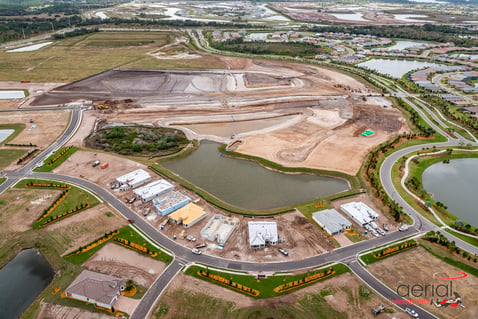What you can do to keep your equipment moving, not missing
BY ADAM HARSHMAN
Originally published in June/July issue of Construction Business Owner
For Robert Turner, fleet operations manager at RIPA & Associates, the phrase “ignorance is bliss” does not apply. In underground utility contracting, ignorance is anything but bliss. With over 900 employees, 450 pieces of heavy machinery and 180 pickup trucks, RIPA is one of the largest underground contractors on the west coast of Florida, taking jobs up and down the coast of the Gulf of Mexico. On any given day, Turner’s jobsites are spread across 125 miles from north to south and 50 miles from east to west, covering six counties.
With so many teams and so much equipment in operation, Turner needs to know exactly where everything is, when regular maintenance is coming up, and what’s sitting idle. Having real-time data on RIPA’s equipment allows Turner to connect idle teams and trucks to new projects, thwart theft and stay on top of regular maintenance to maximize efficiency and prevent costly mistakes.
A transponder-enabled system designed specifically for the construction industry allows Turner to track where RIPA equipment is in the field. The wireless telematics system connects directly to the computer or bus of equipment, delivering real-time data to Turner’s office. Everything from pipe trailers pulled behind semitrucks, to bulldozers, haul trucks, water pumps and motor graders has a transponder.
“If it moves, I’ve got telematics on it,” Turner said. The system delivers actionable data, including hour-meter readings, revolutions per minute, fuel usage, temperatures, asset auto-assignment to job and more to a phone, laptop or—in Turner’s case—a 45-inch monitor in his office. At a glance, he can tell where all RIPA equipment is in the field and what it’s doing.
MAINTAINING THE FLEET As a fleet management device, the telematics system manages the equipment
so Turner doesn’t have to. A “Maintenance Due” report shows the number of run-time hours before maintenance is due for all equipment. Areas shaded in red indicate that service is past due, while areas shaded in yellow indicate that equipment is within 36 hours of its next preventive maintenance. Services can be tracked by hours and/or miles. Maintenance hours are tracked directly on the program, attaching data to specific pieces of equipment, which allows Turner to efficiently time maintenance, rather than wait for something to break down.
Weekly reports are also automatically generated to provide up-to-date information on projects. A weekly “Productivity by Project” report provides a detailed, side-by-side comparison for all equipment on a selected project for the week. This helps Turner determine how well a project is performing and if any equipment can be better utilized elsewhere. Weekly maintenance reports allow Turner to hold his mechanics accountable and let him know what equipment is overdue for service. The reports save Turner time by preventing equipment mix-ups and eliminating the massive dry-erase board or pages of journals that were previously used to track equipment maintenance.

THWARTING THIEVES With expensive equipment in the field, it doesn’t always make sense to bring it back to the shop every night. Sometimes, Turner has to lock up gear and equipment on-site. Previously, he would lock what he could in a warehouse or shed, then move a bulldozer or heavy equipment in front of the door. The procedure didn’t always deter thieves from walking or driving off with expensive gear.
Now, Turner stores his equipment inside a secure Conex container, along with a police siren, strobe light and the telematic system transponders, all connected to solar power. If the door opens, the siren and strobe go off and the system sends emails to Turner and his staff, immediately alerting them to what is happening and on which jobsite.
Turner recalls receiving an alert at 1 a.m. A dozer was starting up at a jobsite. Then, a door to a Conex container was opening. Turner quickly realized this was not a maintenance team that forgot to notify him they were there, but a theft in progress. He immediately notified the local police, who responded in time to foil the robbery attempt. When Turner arrived on the scene, roughly $200,000 worth of electronics and equipment were staged for pickup by the would-be thieves. The jobsite was resecured and no property was lost.
Since the addition of the extra security from the telematics system to the Conex containers, Turner has only lost a few, smaller items due to theft. “Thieves might still grab something within arm’s reach and run away, knowing their presence has been given away, but the item is usually small and way less expensive than other equipment,” Turner said.
NO MORE IDLING
When Turner started using a telematics system in 2012, Caterpillar told him their
tracks would last 4,000 hours. Apparently, that was total machine hours, running and idle—because the system quickly revealed that the average track was lasting 2,300 to 2,800 hours of run time.
Although some of that differential can be attributed to the sandier, abrasive soil in Florida, the biggest reason was their elimination of idle time. The stark difference showed Turner the need to plan as a fleet department to keep the tracks running, so that idle time wouldn’t eat away the service life.
A breadcrumb trail shows Turner detailed location information for all machines in the field. Each time the unit updates (variable from 1- to 5-minute intervals), the packet shows the location of the machine and the reason for the packet (engine on, engine running, engine off, etc.). A GeoZone is provided to automatically track the machine’s activity within that GeoZone as well as when it arrives and leaves the GeoZone.
Now, Turner can plan out where machines go, what sites will need them next, and which machines can be leased out to keep their tracks moving and maximize their lifespan. The first year they used this telematics system, Turner estimates the company saved $1.3 million in preventative maintenance, resale value and fuel usage. Decreasing idle time for RIPA’s loaders alone saved them an estimated $400,000 for the year. The company achieved a radical reduction of idle time and a significant increase in overall productivity.
The RIPA team has become proficient in knowing how much gear is needed based on the size of the project, the distance and the type of project. Turner can now see what’s sitting on a jobsite that he knows should be moving and call up the foreman to see what’s going on. Turner put that savings into expanding the fleet, from 150 to over 1,000 transponder-enabled units in the field.
With so much equipment in the field working on projects across the region, Turner needs to be sure that he is giving accurate information to foremen and other contractors. His telematics system matches the machine number to information about that machine, keeping everything accurate and communicating that information to necessary parties.
Operators in the field can track equipment via mobile app, and Turner keeps an eye on things from his office. Checking in on equipment is simple, and Turner can rest easy knowing accurate information is accessible across all of the company’s jobsites. With easy-to-read, accessible information available at the touch of a screen, Turner can tell where every piece of RIPA equipment is in the field, what it’s doing and when it next needs maintenance. Rather than tracking that himself—a menial and laborious task that is prone to error—telematics tracks it all for him, allowing him to do the more advanced job of sending equipment whereit’s needed next, and lining up contracts for the next project down the line. That allows Turner to manage his fleet more efficiently, preventing idle time, thwarting thieves and saving costly mistakes.
Adam Harshman is national accounts manager for Earthwave Technologies. The company’s FleetWatcher telematics system, designed specifically for heavy construction, provides actionable data so that decisions can be made in real time to drastically impact efficiency. The company is celebrating its twentieth anniversary.
Harshman may be reached at adam.harshman@earthwavetech.com. Visit earthwavetech.com

